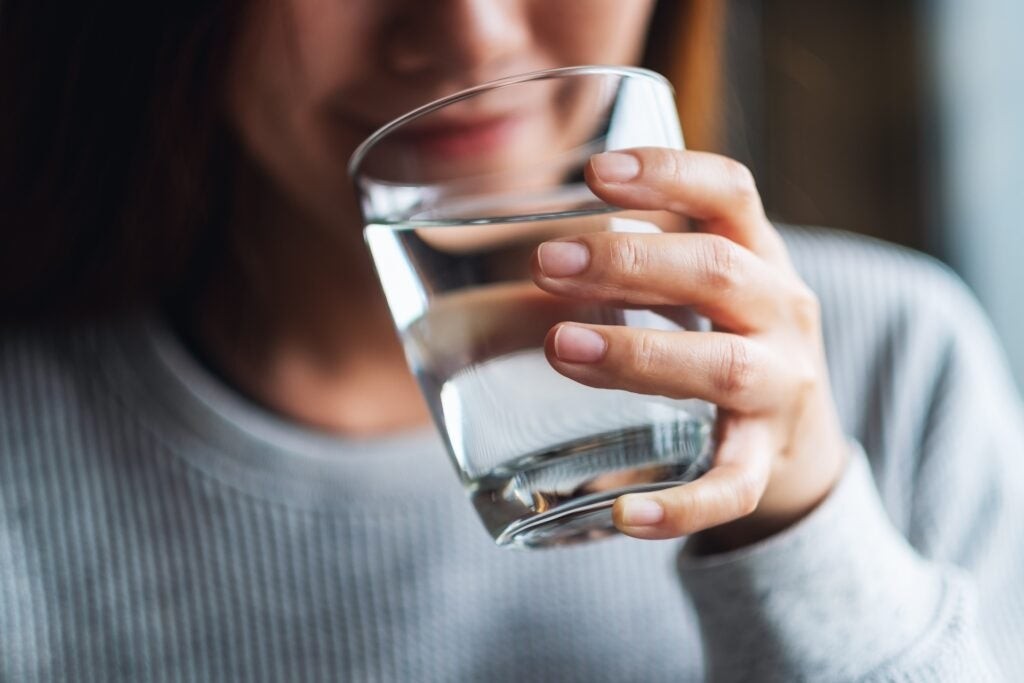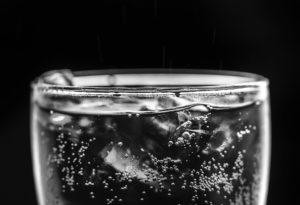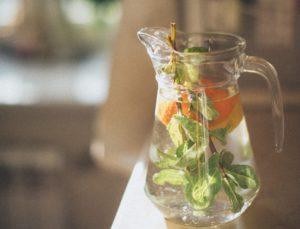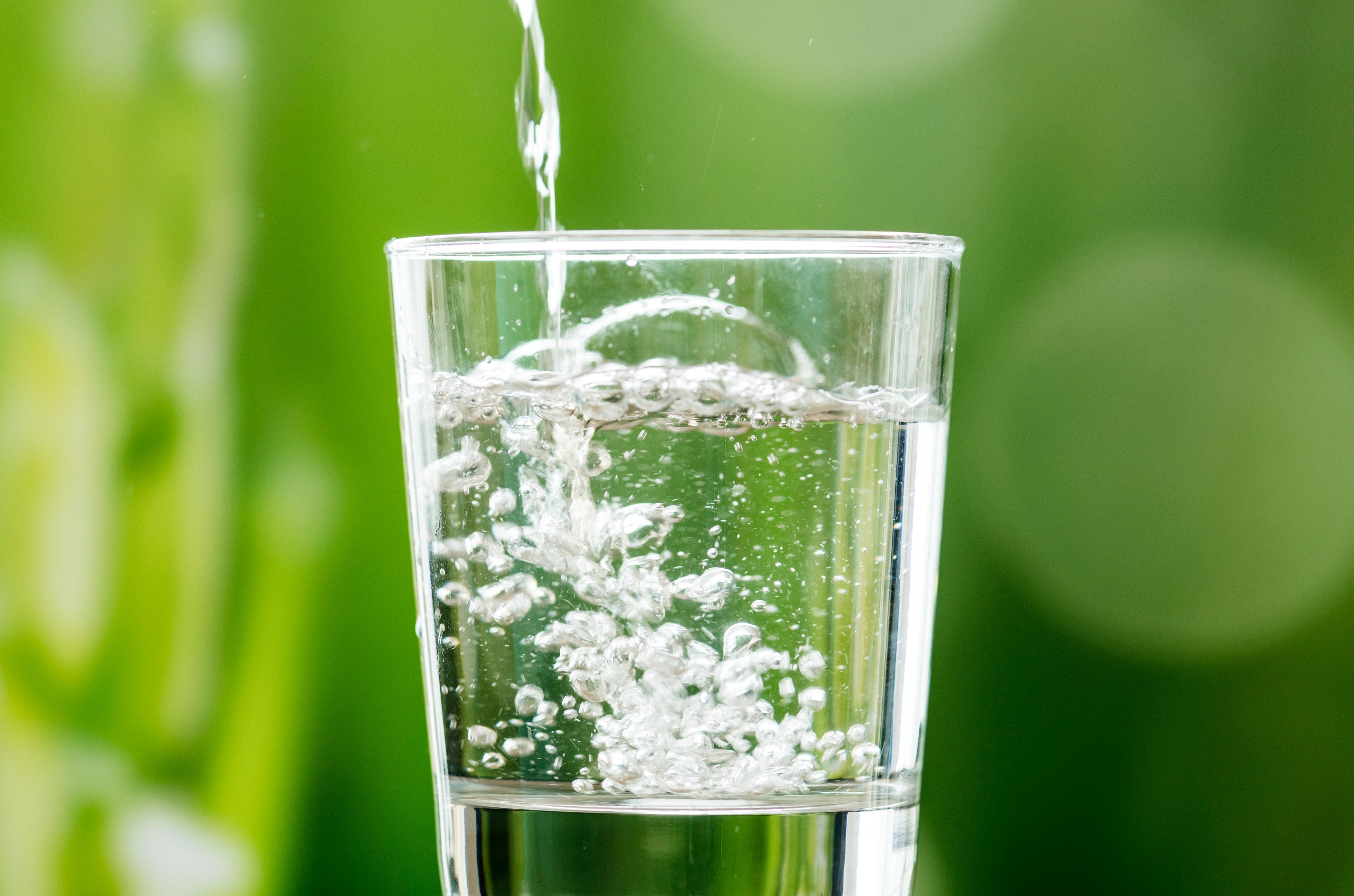Water is undeniably the healthiest beverage choice for most people. In a world filled with sugary drinks and endless beverage options, water stands out as the zero-calorie, readily available, and most essential drink for our bodies. It’s fundamental to countless bodily functions, making it crucial to understand just how much water you need to drink each day.
Water is vital for replenishing fluids lost throughout the day through metabolism, breathing, perspiration, and waste removal. It plays a critical role in regulating body temperature, ensuring you don’t overheat, and acts as a lubricant for your joints and tissues. Maintaining healthy skin and supporting efficient digestion are further benefits of adequate water intake. For anyone seeking a perfect thirst quencher without adding calories, water is the ideal solution to keep your body hydrated and functioning optimally.
Decoding Your Daily Water Needs: How Much Water is Enough?
Water is not just a beverage; it’s an essential nutrient that your body needs at every stage of life. Maintaining optimal hydration is a cornerstone of good health. Consider that water makes up approximately 60% of an adult’s body weight, highlighting its pervasive role within us. Our bodies have a natural mechanism to signal when we need water – thirst. This is the primary alarm, alerting us when our fluid levels are running low. We also instinctively consume beverages with meals, aiding the digestive process. However, sometimes our drinking habits are dictated not by these natural cues but by preconceived notions, such as the widely circulated advice to drink “8 glasses a day.” While popular, this guideline might not be the most accurate or suitable for everyone. Let’s delve into understanding your personalized daily water requirements.
General Water Intake Recommendations: Ounces and Cups
Instead of adhering strictly to the “8 glasses a day” rule, it’s more beneficial to consider general recommendations provided by health authorities. The National Academy of Medicine offers practical guidance, suggesting adequate daily fluid intake of about 13 cups for men and 9 cups for women. It’s important to note that these recommendations refer to total fluids, not just water, and include water from foods as well. To put this in ounces, 13 cups is approximately 104 ounces, and 9 cups is about 72 ounces.
Here’s a breakdown in ounces and cups for clarity:
- Men (19 and older): 13 cups, or approximately 104 ounces
- Women (19 and older): 9 cups, or approximately 72 ounces
It’s crucial to remember that these figures aren’t strict daily targets but rather general guidelines. Individual fluid needs can vary significantly from person to person and even day to day. Factors such as activity level, climate, and overall health play a crucial role in determining how much water each person truly needs. For instance, individuals who are physically active or live in hot climates will likely require more fluids than those who are less active or reside in cooler environments. Conversely, individuals with smaller body sizes might need slightly less. For most people, drinking slightly less than these recommendations on occasion will not negatively impact their health. The body is quite adept at signaling its needs.
Factors That Influence Your Water Needs
Several factors can significantly impact your daily water requirements. Being aware of these variables can help you adjust your fluid intake accordingly:
- Physical Activity: Exercise, especially intense workouts, leads to fluid loss through sweat. The more active you are, the more fluids you’ll need to replenish.
- Climate: Hot and humid weather increases sweating, demanding higher fluid intake to prevent dehydration. Surprisingly, cold weather can also increase fluid needs due to increased urination and respiration.
- Fever: When you have a fever, your body temperature rises, and you lose more fluids. Increased fluid intake is crucial during illness to prevent dehydration.
- Extreme Temperatures: Exposure to very hot or cold climates, even without fever or exercise, can increase fluid loss and necessitate greater water consumption.
- Fluid Loss Conditions: Conditions like vomiting and diarrhea cause significant fluid loss, requiring immediate and increased fluid replacement to avoid dehydration.
- Alcohol Consumption: Alcohol is a diuretic, meaning it increases urine production. Consuming alcoholic beverages can lead to dehydration if not balanced with adequate water intake. It suppresses anti-diuretic hormone, which usually signals the kidneys to conserve water.
- Caffeine Intake: While caffeine has been traditionally viewed as a diuretic, moderate caffeine consumption (up to about 2 cups of coffee daily) doesn’t typically lead to dehydration. Caffeinated beverages can still contribute to your overall daily fluid intake.
Monitoring Hydration: Urine Color and Volume
Your urine can provide a practical, albeit rough, indication of your hydration status. Generally, the darker your urine, the more concentrated it is, suggesting your body is conserving water and you may need to drink more. Lighter-colored urine, on the other hand, usually indicates good hydration.
However, it’s important to note that urine color can be influenced by other factors such as foods, medications, and vitamin supplements. Certain foods and supplements can alter urine color regardless of hydration levels. Additionally, smaller volumes of urine, especially if dark in color, can be a stronger indicator of dehydration. Pay attention to both the color and volume of your urine as a general guide to your hydration.
Water from Foods: Don’t Forget Dietary Sources
While beverages are the most direct way to hydrate, a significant portion of our daily water intake actually comes from the foods we eat. It’s estimated that about 20% of our total water intake is derived from water-rich foods. Incorporating these foods into your diet can contribute significantly to your overall hydration. Excellent sources of water-rich foods include:
- Lettuce and leafy greens
- Cucumbers
- Bell peppers
- Summer squash
- Celery
- Berries
- Melons
Including these hydrating fruits and vegetables in your meals and snacks can naturally boost your fluid intake throughout the day.
Daily Adequate Intake Chart by Age Group
For a clearer picture of recommended daily water intake across different age groups, the National Academy of Medicine provides the following guidelines:
| Age | Daily Adequate Intake |
|---|---|
| 1-3 years | 4 cups, or 32 ounces |
| 4-8 years | 5 cups, or 40 ounces |
| 9-13 years | 7-8 cups, or 56-64 ounces |
| 14-18 years | 8-11 cups, or 64-88 ounces |
| Men, 19 and older | 13 cups, or 104 ounces |
| Women, 19 and older | 9 cups, or 72 ounces |
| Pregnant women | 10 cups, or 80 ounces |
| Breastfeeding women | 13 cups, or 104 ounces |




This chart provides a useful reference point for ensuring adequate hydration for yourself and your family members across different life stages.
Preventing Dehydration: Is Thirst a Reliable Guide?
A healthy body is remarkably designed to signal thirst when fluid levels decrease, prompting us to drink and restore balance. Thirst is a complex sensation, driven by both physiological needs and behavioral cues. Physiologically, when your body starts to lose water, your brain triggers the thirst mechanism. Behaviorally, factors like the temperature of water can influence how much we drink. Interestingly, research suggests people tend to drink more water when it’s at room temperature, even though colder drinks are often perceived as more palatable. Social settings can also play a role, often encouraging us to drink and eat more than we might otherwise.
However, relying solely on thirst as a hydration guide isn’t foolproof, especially as we age. The body’s ability to regulate fluid intake and the sensation of thirst can diminish with age. Studies have shown that both fluid intake regulation and thirst response are often impaired in older adults. This means elderly individuals might not feel thirsty even when they are dehydrated. Research reviews have indicated that common indicators of dehydration in older adults, such as urine color, urine volume, and feeling thirsty, are not consistently reliable and shouldn’t be used as sole indicators.
Certain health conditions that affect cognitive function, like stroke or dementia, can further impair thirst sensation. Individuals may also consciously limit fluid intake due to concerns about incontinence or difficulty accessing bathroom facilities. Beyond these specific populations, research indicates that athletes, individuals who are ill, and infants might also not have a reliable sense of thirst to adequately meet their fluid needs. Even mild dehydration can lead to noticeable negative symptoms. Therefore, individuals who cannot fully depend on thirst signals may benefit from adopting proactive hydration strategies. For example, a practical approach is to fill a 20-ounce water bottle and aim to drink four of these throughout the day, sipping regularly. Another simple method is to make it a habit to drink a large glass of water with each meal and snack.
Recognizing Symptoms of Dehydration
Even a mild water deficit, as little as 2% dehydration, can trigger noticeable symptoms. Being aware of these early warning signs is crucial for preventing more severe dehydration. Common symptoms include:
- Fatigue and lethargy
- Confusion or short-term memory lapses
- Mood changes, such as increased irritability or feelings of depression
Health Risks Associated with Dehydration
Chronic or recurrent dehydration can increase the risk of developing certain medical conditions. Staying well-hydrated is a preventative measure against:
- Urinary tract infections (UTIs)
- Kidney stones
- Gallstones
- Constipation
Maintaining adequate hydration is a simple yet powerful way to support overall health and reduce the risk of these common health issues.
Alkaline Water: Separating Hype from Hydration
Alkaline water has gained popularity recently, often fueled by celebrity endorsements and claims of various health benefits ranging from weight loss to cancer cures. The underlying theory is similar to the alkaline diet trend, suggesting that alkaline water can counteract the supposed negative effects of acid-producing foods like meat, sugar, and certain grains.
The pH scale, ranging from 0 to 14, measures acidity and alkalinity. A higher pH indicates alkalinity, while a lower pH signifies acidity. The human body meticulously regulates blood pH to a narrow range around 7.4, as deviations towards either extreme can lead to adverse health effects and even be life-threatening. However, dietary intake alone is unlikely to drastically alter blood pH in healthy individuals. Significant pH imbalances are usually associated with underlying medical conditions such as uncontrolled diabetes, kidney disease, chronic lung disease, or alcohol abuse.
Alkaline water typically has a pH of 8-9, slightly higher than the pH of regular tap water, which is around 7. This higher pH is often attributed to a greater mineral or salt content. Some natural water sources can be alkaline due to minerals absorbed from rocks. However, most commercial alkaline water brands are produced using ionizers, which supposedly separate alkaline components and filter out acidic components, raising the pH. Some people also create alkaline water at home by adding alkaline substances like baking soda to regular water.
Despite the hype, scientific evidence supporting the acid-alkaline theory, also known as the acid-ash theory, is not conclusive. This theory proposes that consuming a high proportion of certain foods can slightly lower blood pH, especially without sufficient intake of alkaline-promoting foods like fruits, vegetables, and legumes. However, controlled clinical trials have not demonstrated that diet alone can significantly alter blood pH in healthy individuals. Furthermore, a direct link between blood pH within the low-normal range and chronic disease development in humans has not been definitively established.
BOTTOM LINE: If drinking alkaline water motivates you to increase your overall water intake, then it’s not inherently harmful. However, it’s highly probable that plain, regular water provides similar health benefits simply by keeping you well-hydrated. These benefits include improved energy levels, better mood, and enhanced digestive health – all achievable with regular water consumption.
Is It Possible to Drink Too Much Water? Water Toxicity Explained
While it’s generally challenging to drink too much water, it is indeed possible to overhydrate, although rare. There isn’t a defined Tolerable Upper Intake Level for water because healthy kidneys can typically manage and excrete excess water through urine and sweat. However, a condition known as water toxicity, or hyponatremia, can occur in rare instances. This happens when an exceptionally large amount of fluid is consumed in a short period, overwhelming the kidneys’ ability to process and excrete it quickly enough.
This rapid and excessive water intake leads to hyponatremia, a dangerous condition where sodium levels in the blood become dangerously diluted. The excess water in the body dilutes the concentration of sodium in the bloodstream, leading to an imbalance. Symptoms of hyponatremia can range from confusion and nausea to more severe manifestations like seizures and muscle spasms.
Hyponatremia is most commonly observed in individuals with underlying health issues, particularly those with kidney dysfunction, which impairs their ability to regulate fluid balance. It can also occur under conditions of extreme heat stress or during prolonged, strenuous exercise where individuals drink excessive amounts of water while simultaneously losing sodium through sweat. Endurance athletes, such as triathletes and marathon runners, are at a higher risk due to this combination of high water intake and sodium loss. Women and children are also considered more susceptible to hyponatremia due to their smaller body size, which means a relatively smaller amount of excess water can have a more significant impact on their sodium balance.
Making Water More Appealing: Fun and Flavorful Options
Water is an exceptional beverage choice – calorie-free and sugar-free. However, for some who are accustomed to sugary drinks, plain water can initially seem bland. To increase your water consumption without sacrificing flavor or to simply add variety to your daily hydration routine, consider these refreshing water-based beverage ideas:
Infused Water: Natural Flavor Boost
Instead of purchasing commercially flavored waters, which can be expensive and sometimes contain added sugars or artificial sweeteners, you can easily create your own delicious infused water at home. Simply add any of the following ingredients to a glass or pitcher of cold water:
- Sliced citrus fruits or zest (lemon, lime, orange, grapefruit)
- Crushed fresh mint leaves
- Peeled, sliced fresh ginger or sliced cucumber
- Crushed berries (strawberries, raspberries, blueberries)
Experiment with different combinations to discover your favorite infused water flavors.
Sparkling Water with a Splash of Juice: A Healthier Alternative to Soda
While sparkling juices might seem like a healthier option, they can still be surprisingly high in calories, sometimes comparable to sugary sodas. A better homemade alternative is to create your own sparkling juice spritzer. Start with 12 ounces of unsweetened sparkling water and add just an ounce or two of 100% fruit juice for a hint of flavor. Enhance the taste further with slices of citrus fruit or fresh herbs like mint.
TIP: To reduce waste and promote sustainability, consider switching away from single-use plastic water bottles. Invest in a reusable water thermos, ideally a colorful 20-32 ounce size, that is easy to clean and carry with you throughout the day. This simple change can make staying hydrated more convenient and environmentally friendly.
Are Seltzers and Fizzy Waters Healthy Hydration Choices?
Sparkling water, seltzer, and other fizzy waters are created through carbonation – a process of dissolving carbon dioxide gas in water under pressure. This process lowers the pH of water, making it slightly more acidic. Concerns have been raised about whether this acidity might harm dental enamel or bone health. However, research has not found a link between unsweetened carbonated beverages and dental decay unless they also contain sugars or artificial sweeteners like high fructose corn syrup. Similarly, studies have not shown that carbonated waters negatively impact bone mineral density. The bone health concerns are more strongly associated with the high phosphorus content found in dark cola soft drinks, rather than the carbonation itself.
BOTTOM LINE: Unsweetened carbonated waters, like seltzer and sparkling water, are safe to drink and represent a healthy beverage choice. They are not associated with the health problems linked to sweetened, carbonated beverages like soda. If you enjoy the fizz, unsweetened sparkling water is a great way to stay hydrated.
Related Articles:
- Healthy Drinks
- Sugary Drinks
- Coffee
- Tea
- Alcohol
- Calcium and Milk
References
- National Academies of Sciences, Engineering, and Medicine. 2005. Dietary Reference Intakes for Water, Potassium, Sodium, Chloride, and Sulfate. Washington, DC: The National Academies Press. https://doi.org/10.17226/10925.
- Kenney WL, Chiu P. Influence of age on thirst and fluid intake. Med Sci Sports Exerc. 2001 Aug;33(8):1524-32.
- মাহবুব , Hoque, et al. Clinical indicators of dehydration in older people: a systematic review and meta-analysis. BMC Geriatr 19, 30 (2019). https://doi.org/10.1186/s12877-019-1049-8
Terms of Use
The contents of this website are intended for educational purposes and are not a substitute for professional medical advice. Always consult with a qualified healthcare provider for any health concerns or before making any decisions related to your health or treatment. Never disregard professional medical advice or delay seeking it because of information you have accessed on this website. The Nutrition Source does not endorse or recommend any specific products.
